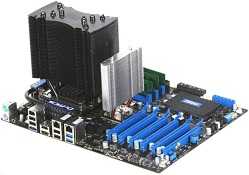Choosing the Right Heatsink for Your Application
In an era where electronics are an integral part of our daily lives, managing heat is a critical concern. Whether you’re designing a high-performance gaming PC, a robust industrial machine, or a compact smartphone, one thing is certain: excessive heat can cripple your device’s performance and even lead to its premature demise. This is where heatsinks come into play. Selecting the right heatsink is crucial for efficient thermal management, and it involves careful consideration of factors like thermal resistance, form factor, airflow, and more. In this article, we’ll guide you through the process of choosing the perfect heatsink for your application.
Understanding the Basics
Before delving into the specifics, let’s briefly touch on the fundamentals. A heatsink is essentially a passive thermal management component that helps dissipate heat generated by electronic components, such as CPUs, GPUs, power transistors, and more. It does this by increasing the surface area exposed to the surrounding air, allowing heat to be transferred away from the device. The effectiveness of a heatsink depends on several key factors:
Thermal Resistance (Rth)
Thermal resistance, often denoted as Rth, is a crucial parameter that measures how effectively a heatsink conducts heat away from the source. It’s typically measured in degrees Celsius per watt (°C/W). Lower thermal resistance values indicate better performance. When choosing a heatsink, you should aim for a low Rth to ensure efficient heat dissipation.
Form Factor
The physical size and shape of the heatsink are significant considerations. The form factor should align with your application’s available space and design constraints. Smaller heatsinks may be suitable for compact devices, while larger ones can handle more substantial heat loads.
Material
Heatsinks are commonly made from aluminum or copper. Aluminum is lightweight and cost-effective, while copper offers superior thermal conductivity. The choice of material should be based on your specific needs and budget.
Mounting Mechanism
Consider how the heatsink will be attached to the heat source (e.g., a CPU or power transistor). Common mounting mechanisms include clips, screws, and adhesive thermal compounds. The mounting method should ensure good thermal contact between the component and the heatsink.
Airflow
Heatsinks rely on airflow to dissipate heat. Depending on your application, you might need to consider whether natural convection (passive cooling) is sufficient or if forced convection (using fans) is necessary. Ensure there’s adequate ventilation around the heatsink to maximize its effectiveness.
Tips for Choosing the Right Heatsink
Now that we’ve covered the basics, let’s delve into practical tips for selecting the appropriate heatsink for your application:
- Calculate Heat Dissipation: Begin by calculating the heat dissipation of your electronic component. You can find this information in the component’s datasheet or technical specifications. Knowing the power (in watts) that needs to be dissipated is essential for selecting a heatsink with the right thermal resistance.
- Consider Thermal Resistance: Choose a heatsink with a thermal resistance that matches or exceeds your requirements. Keep in mind that the total thermal resistance in a system includes the resistance of the heatsink, any thermal interface materials (TIMs), and the surrounding air. Factor in all these elements to ensure effective cooling.
- Evaluate Space Constraints: Assess the available space for the heatsink in your device. Make sure the heatsink’s dimensions fit within these constraints while allowing sufficient airflow. Smaller heatsinks may suffice for applications with limited space, but larger heatsinks often offer better performance.
- Optimize Material Selection: Decide whether aluminum or copper is more suitable for your application. Copper heatsinks have higher thermal conductivity but are heavier and more expensive. Aluminum heatsinks are lightweight and cost-effective but may not perform as well under extreme conditions.
- Choose the Right Mounting Mechanism: Select a mounting mechanism that ensures good thermal contact between the component and the heatsink. Thermal compounds or pads can help fill gaps and enhance heat transfer. Follow manufacturer guidelines for installation to maximize efficiency.
- Assess Airflow Needs: Determine if your application requires natural or forced convection. Passive cooling works well in many scenarios, but for high-power applications, consider incorporating fans or other cooling solutions to improve heat dissipation.
- Test and Iterate: Once you’ve chosen a heatsink, conduct thermal testing to ensure it meets your requirements. If necessary, iterate and make adjustments to your thermal management system to achieve optimal performance.
In short
Selecting the right heatsink is a critical step in ensuring the reliable and efficient operation of electronic devices. By considering factors like thermal resistance, form factor, material, mounting mechanism, and airflow, you can make an informed choice that suits your specific application. Remember that effective thermal management not only enhances performance but also extends the lifespan of your electronics, making it a wise investment in the long run.

